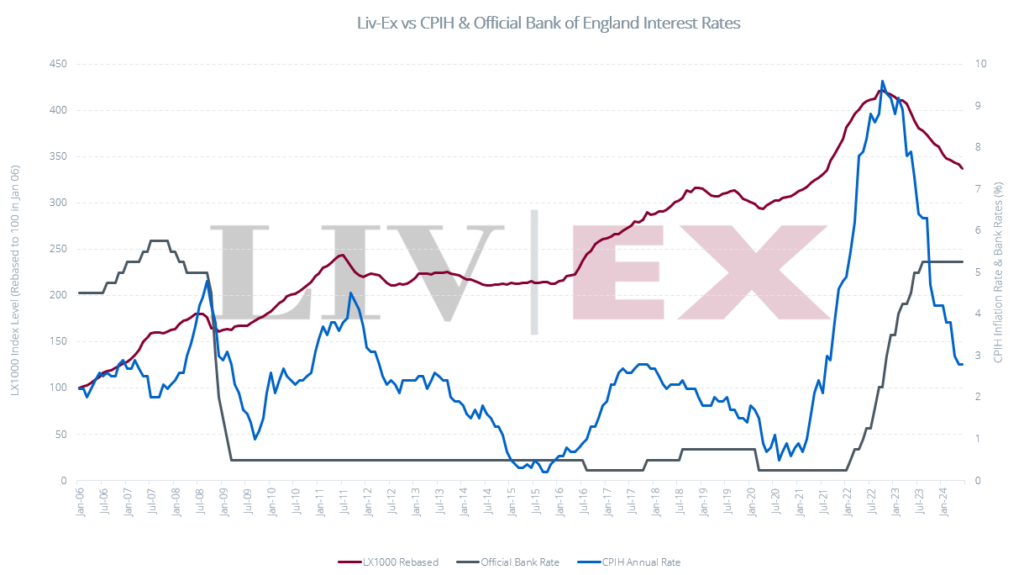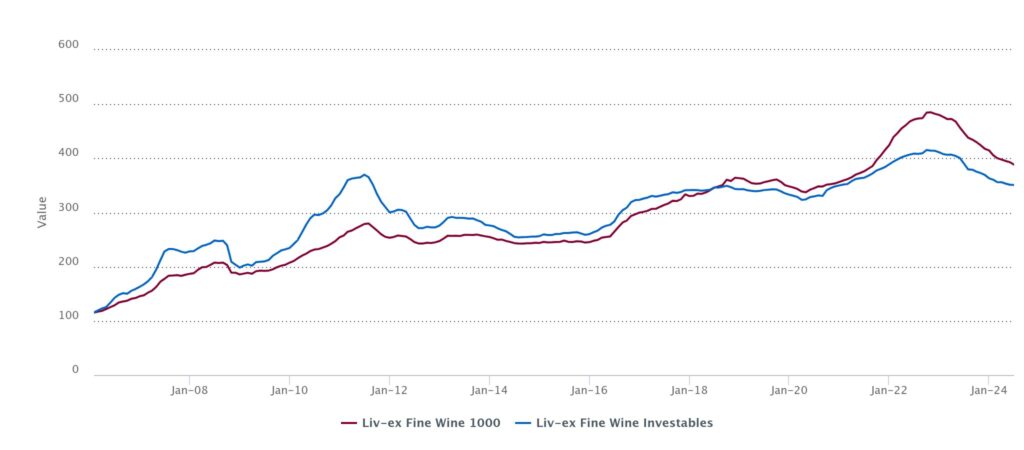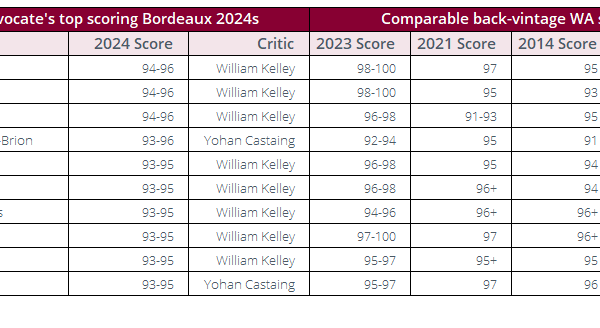What’s happening in the market?
So far this week, Bordeaux has led the market with a 42.0% share of traded value. The region saw trades of some rare older vintages, including Château Mouton Rothschild 1945, Château Lafite Rothschild 1974 and Petrus 2002.
Burgundy came in second with an 18.3% share, while Champagne followed with 11.5%. Burgundy was buoyed by Domaine de la Romanée-Conti’s La Tâche 2011, which traded below its last auction price of £37,000.
Piedmont saw an increased share of trade on last week’s close, with wines from 15 different producers changing hands.
Today’s deep dive: how will an interest rate cut affect the fine wine market?
As reported by the Financial Times this morning, it is expected that on Thursday, the Bank of England will cut the official UK interest rate, which has remained at a 17-year high of 5.25% since mid 2023. How might monetary easing impact the fine wine market, and where do the opportunities lie?
Prices of wine, considered both a luxury good and an investible, are impacted by interest rate changes via multiple channels. Looking at the chart below (showing the Liv-ex Fine Wine 1000, Bank of England interest rate and the Consumer Prices Index (CPIH)), we can see several examples of a decrease in interest rate directly predating an upward shift in the market – early 2009, mid 2016 and early 2020. We can understand these upward shifts largely as a product of increased demand, driven both by end-consumers and investors. While an interest rate cut improves outlooks across the industry, those seeking to capitalise may bet on some indices rising faster than others. Moreover, Euro and Dollar buyers are set to benefit from the cut’s effects on exchange rates.
As a luxury good, demand for wine is impacted directly by a willingness and ability of consumers to spend. In the immediate aftermath of Covid-19 (February 2020), for example, the Bank of England cut interest rates to encourage economic growth. This resulted in a period of increased spending across sectors, including the wine sector. Increased disposable income drives demand, in particular, for mid-range wines (£1,000<£2000 per 12×75) — those that become available to a larger group of consumers only during periods of prosperity.
Should the Bank of England cut interest rates, thereby decreasing the cost of borrowing, we might expect spending to increase. Eventually, this will flow into the market for fine wine, with buyers finally able to spend more on luxury goods. In time, prices will rise
The chart below shows price movements of the Liv-ex Fine Wine 1000 and Liv-ex Investables index since 2006. As we can see, during the inflationary period between early 2021 and mid 2022, prices of the Investables index remained flatter than the 1000. It is likely that prices of these kinds of wines are less dependent on propensity to spend, and, like stock prices, are more dependent on expectations of future returns. This theory is supported by the sharp price drop of the Investables index in August 2011, in sync with the stock market crash. Buyers using wine as an investment are less driven by affordability, and more driven by perceptions of safety in the market.
The Liv-ex 1000 and Liv-ex Investables since 2006
As we know, high interest rates make saving money more attractive than spending. If interest rates decline, we might expect to see an increase in spending on investment-grade bottles by private collectors. Still, even at a lower interest rate, market participants require a degree of certainty to inform their investments. Over the past year, we have reported on the fall of Burgundy prices, underwhelming En Primeur pricing leaving warehouses filled with stock in Bordeaux, US and Chinese tariffs – the list goes on. While the market is no longer in free fall, this combination of variables is unlikely to fill investors with confidence. Unlike in previous years, when an interest rate cut has had an immediate and pronounced effect on investment, a period of steadier growth may be required before fine wine becomes an attractively stable investment opportunity once again. As we recently reported, offer exposure for the likes of mature Domaine de la Romanée-Conti is higher than ever – an interest rate cut may not immediately change this. Still, those with sufficient patience (and capital) might choose to dip a toe in the water.
LIVE opportunities
In our recent report on trade in H1 2024, we observed that, across all indices, bid:offer ratios have been falling fast. A sustained decrease in interest rates will be needed to reverse this trend. But those first out the gate will likely be the greatest beneficiaries of the change in direction. Where to begin? The best opportunities may be found among the tightest markets currently on the exchange.
An interest rate cut in the UK is also good news for foreign-currency buyers. As was the case following the European Central Bank’s cut in June, a decrease in interest rate tends to weaken domestic currency. Already, the Pound Sterling is seeing drops as traders tactically short before the cut. If the Federal Reserve holds off on lowering their rate until September or October, Dollar buyers, already benefitting from their currency’s strength, stand to turn even larger profits. Now may also be the time for Japanese buyers to re-enter the market – with the Bank of Japan raising interest rates on Tuesday night, the Yen has already strengthened by 4% on the Pound so far this week.
Liv-ex analysis is drawn from the world’s most comprehensive database of fine wine prices. The data reflects the real time activity of Liv-ex’s 620+ merchant members from across the globe. Together they represent the largest pool of liquidity in the world – currently £100m of bids and offers across 20,000 wines.






